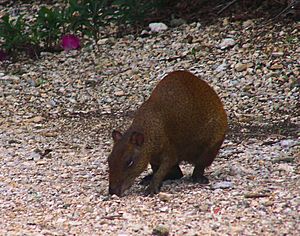Grand Cayman facts for kids
Grand Cayman is the biggest of the three Cayman Islands. It's about 196 square kilometers (76 square miles) and is home to George Town, which is the capital city. On the island, towns are often called "districts."
Contents
Grand Cayman's Geography
Grand Cayman makes up 76% of all the land in the Cayman Islands. The island is about 35 kilometers (22 miles) long. Its widest part is about 13 kilometers (8 miles) across. The land goes from sea level at the beaches up to 18 meters (60 feet) high. This higher land is found along the Mastic Trail on the North Side of the island.
Island Districts: Where People Live
Grand Cayman Island has five of the six main areas, or districts, of the Cayman Islands. These are Bodden Town, East End, George Town, North Side, and West Bay.
Bodden Town: The Old Capital
- Bodden Town was started in the 1700s. It's in the middle of Grand Cayman Island. The village of Bodden Town used to be the capital of the Cayman Islands. About 5,764 people live here.
East End: Nature and Relaxation
- The East End district is on the eastern side of Grand Cayman. It has the Village of East End, many natural sights, restaurants, and places to stay. About 1,371 people live in this area.
George Town: The Capital City
- George Town is the capital of the Cayman Islands. It's also famous around the world for offshore banking and investments. About 20,676 people live in George Town.
North Side: Quiet Spots and Glowing Water
- The North Side district includes places like Kaibo, Rum Point, and Breakers. About 1,079 people live here. Sand Point Cove in Rum Point has a special place called a Bioluminescent Bay, or Bio Bay. Here, the water glows at night because of tiny living things.
West Bay: Fun for Tourists
- West Bay has many places that tourists like to visit. These include the Cayman Turtle Farm and the Cayman Motor Museum. Towns in West Bay are Seven Mile Beach, Hell, and West Bay Village. About 8,243 people live in this district.
The last district is called Sister Islands. It includes the islands of Cayman Brac and Little Cayman. About 1,937 people live on these islands.
Plants and Animals of Grand Cayman
Amazing Plants: Grand Cayman's Flora
You can see many different kinds of plants at the Queen Elizabeth II Botanic Park. This park is in the North Side District. You might find wild banana orchids, ghost orchids, and thatch palm trees. There are also red birch trees and mahogany trees.
The park also has many fruit trees like avocado, mango, guinep, naseberry, breadfruit, and tamarind. You can also see yellow mastics and black mastics in the park. These trees are also found along the 3.2-kilometer (2-mile) long Mastic Trail. Outside the park, you can spot coconut palms, Casuarina pine trees, mangroves, and poinciana trees all over Grand Cayman.
Cool Animals: Grand Cayman's Fauna
You can find many interesting animals around the island. These include blue iguanas, Grand Cayman amazon parrots, and Central American agoutis. There are also land crabs called Gecarcinus ruricola. The Cayman Islands Turtle Farm is in the West Bay district. This farm raises green sea turtles. They raise them for food and also to release them into the wild.
The farm raises over 1,800 turtles each year. Between 1980 and 2006, they released about 30,600 turtles into the ocean. Each released turtle has a special mark. This means they have been seen all over the Caribbean Sea.
There are four types of snakes that are native to Grand Cayman. There are also two types of invasive snakes. All of these snakes are mostly harmless. The largest is the corn snake, which is an invasive species. It can grow to about 1.5 meters (5 feet) long, but it is rarely seen. The smallest is the brahminy blind snake, which is also invasive and rarely seen. It grows to about 15 centimeters (6 inches).
The most common snake is the native Cayman racer snake. It can grow to about 1.8 meters (6 feet), but snakes around 0.9 meters (3 feet) are more common. These snakes usually try to get away if you see them. If they feel trapped, they might act in a threatening way. The Cayman racer snake has a mild venom. It uses this venom to stop its prey from moving. If it bites a human and holds on for a long time, it can cause some swelling and bruising. However, a quick bite usually doesn't cause any reaction in people. The other three native snake species are the Cayman ground boa, Cayman blind snake, and Cayman water snake.
Who Lives on Grand Cayman?
Grand Cayman is home to about 95% of all the people living in the Cayman Islands.
Grand Cayman's Economy
Offshore Banking: A Financial Hub
Grand Cayman has almost 600 banks and trust companies. This includes 43 of the 50 biggest banks in the world. Because of all these financial businesses, banking, investments, and insurance are very important to Grand Cayman's economy.
Tourism: Fun in the Sun
Grand Cayman Island has many natural attractions. These include the blow holes in the East End district, where water shoots up from the sea. There's also the Mastic Trail, which goes through the middle of the island. Other popular spots are Hell in West Bay and the Queen Elizabeth II Botanic Park.
Water sports like scuba diving and snorkeling are very popular activities. Grand Cayman is famous for its beautiful coral reefs and underwater walls. It also has several shipwrecks that divers love to explore.
Seven Mile Beach has the most visitors and tourists on the island. This is because it has many clubs, resorts, and hotels.
Images for kids
See also
 In Spanish: Gran Caimán para niños
In Spanish: Gran Caimán para niños













